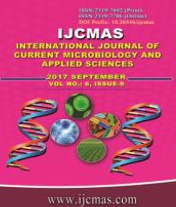


 National Academy of Agricultural Sciences (NAAS)
National Academy of Agricultural Sciences (NAAS)

|
PRINT ISSN : 2319-7692
Online ISSN : 2319-7706 Issues : 12 per year Publisher : Excellent Publishers Email : editorijcmas@gmail.com / submit@ijcmas.com Editor-in-chief: Dr.M.Prakash Index Copernicus ICV 2018: 95.39 NAAS RATING 2020: 5.38 |
A field experiment was conducted during the year 2011-12 and 2012-2013 at Department of Agronomy, Dr. Panjabrao Deshmukh Krishi Vidyapeeth, Akola to study the effect of split application of N and K fertilizers on growth, yield attributes, nutrient uptake and to economize the fertilizer requirement of Bt cotton under fertigation. The experiment was laid out in randomized block design with four replications and five treatments imposed having four different levels of drip fertigation in five splits at 50 per cent, 75 per cent, 100 per cent and 125 per cent of recommended dose of N and K given through fertigation and P as basal compared with 100 per cent soil application of fertilizers. The results revealed that, all the growth parameters viz. plant height, leaf area index, dry matter accumulation per plant, root dry weight, yield attributes viz. sympodial branches, bolls picked and seed cotton yield were substantially enhanced by drip fertigation level at 125 per cent recommended dose of N and K than lower fertigation levels (50, 75 and 100 per cent) and over conventional soil application with 100 per cent RDNK Kg ha-1. Drip fertigation at 125 per cent RDNK ha-1 had recorded higher seed cotton yield of 3680 Kg ha-1 and 3326 Kg ha-1 during 2011-12 and 2012-13 respectively. Drip fertigation at 75 per cent RDNK ha-1 recorded comparable yield with 100 per cent recommended dose of fertilizers applied through soil by conventional method during both the years of study indicating 25 per cent fertilizer saving through fertigation when compared to conventional soil application of fertilizers. The nutrient uptake was favourably increased with higher level of fertigation compared with lower levels and soil application method. At all the stages of crop growth, higher uptake of N, P and K were observed at 125 per cent levels of N and K fertigation. Progressive increase in applied level of N and K correspondingly increased the nutrient uptake and lower uptake was noticed at lower level of fertigation (50 per cent) at all the stages during both years of study.
 |
 |
 |
 |
 |